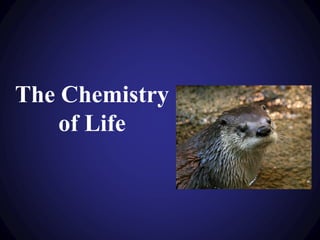
The chemistry of life chapter 3
- 2. Organic Molecules Generate Life’s Form and Function • Organic molecules – Contain carbon and hydrogen • 4 most abundant types – Carbohydrates, lipids, proteins, and nucleic acids • Monomers link together to form polymers – Link by dehydration synthesis – Broken apart by hydrolysis
- 3. Functional Groups of Organic Molecules
- 4. Group Example Hydroxyl Methanol Carbonyl Butanone Carboxyl Acetic acid Functional Groups of Organic Molecules Group Example Amino Methylamine Phosphate Glyceraldehyde 3-phosphate
- 5. Type of Molecule Chemical Structure Functions Carbohydrates Simple Sugars Monosaccharides Disaccharides quick fuel for metabolism, being used both as an energy source (glucose being the most important in nature) and in biosynthesis Complex Carbohydrates (starch, cellulose, chitin) Polysaccharides cellulose and chitin are structural polysaccharides; others are used for energy Lipids Triglycerides (fats, oils) glycerol and three fatty acids enable the bidirectional transference of adipose fat and blood glucose from the liver Phospholipids glycerol, a diglyceride, a phosphate group, and a simple organic molecule major component of all cell membranes as they can form lipid bilayers Sterols fused four-ring core structure important component of membrane lipids; hormones Waxes long chain fatty acids and primary alcohols provide waterproofing (are insoluble in water) Proteins one or more long chains of amino acid residues assist in cell function Nucleic Acids (DNA, RNA) polynucleotides—strands composed of nucleotides store and use genetic information Macromolecules of Life
- 6. Carbohydrates • Monosaccharides – simple sugars – 5, 6 carbon atoms – Glucose, fructose
- 7. Carbohydrates • Disaccharides – 2 monosaccharides joined by dehydration synthesis – Lactose, maltose (sugar cane, sugar beets) Fructose Sucrose
- 8. Oligosaccharides • Intermediate length carbohydrates – 3 – 100 monomers together – Glycoproteins – used for immunity • Blood types – protein on the surface of blood cell for A, B, AB, O
- 9. Oligosaccharides • Intermediate length carbohydrates – 3 – 100 monomers together – Glycoproteins – used for immunity • Blood types – protein on the surface of blood cell for A, B, AB, O
- 10. Complex Carbohydrates - Polysaccharides • Complex carbohydrates – Polysaharides – Cellulose, chitin, starch, glycogen
- 11. Lipids • Lipids are hydrophobic and Energy-Rich – Do not dissolve in water – Not polymers – extremely diverse – Triglycerides • 3 fatty acids plus glycerol – Saturated versus unsaturated
- 12. Function of Fats • Fats protect , insulate and store energy • When energy resources low, body will pull from fat stores (i.e. fat pad behind the eye)
- 15. Lipids • Lipids are hydrophobic and Energy-Rich – Sterols • 4 interconnected carbon rings • Vitamin D, cortisone, cholesterol, testosterone, estrogen Cholesterol Testosterone
- 16. Lipids • Lipids are hydrophobic and Energy-Rich – Waxes • Fatty acids combined with alcohols • Stiff, water-repellant material Honey encased in beeswax
- 17. Phospholipids • Amphipathic molecules – Polar head – Nonpolar tails
- 18. Proteins • Proteins – Carbohydrates with N atom – Need them to carry out most chemical reactions in the body – Made of amino acids • C atom + COOH, NH2, R-group (distinguishing character) • 20 types • Combined into proteins by peptide bonds – Polypeptide = chain of amino acids – Protein = polypeptide shaped into protein shape – Denaturation – Modifying the structure of a protein changing/destroying its function • pH, heat, salt
- 19. Proteins
- 20. Proteins • Proteins Are Complex and Highly Versatile – Protein folding • Primary (1º) structure • Secondary (2º) structure • Tertiary (3º) structure • Quaternary (4º) structure – Genetic code specifies amino acid sequence
- 22. Proteins • Denaturation: loss of function – Function depends on overall shape – Vulnerable to conditions that alter shape • Heat, salt, pH
- 23. Nucleic Acids • Nucleic Acids Store and Transmit Genetic Information – Nucleic acid (polymer) • DNA – stores genetic information • RNA – enables cells to use DNA – Nucleotide (monomer) • Nitrogenous base – A, G, T, C, or U
- 25. DNA
Notes de l'éditeur
- Image from open stax
- Replace table
- Content from “Functional Groups” on Wikipedia. https://en.wikipedia.org/wiki/Functional_group#Groups_containing_oxygen
- “Carbohydrate” https://en.wikipedia.org/wiki/Carbohydrate “Polysaccharides” https://en.wikipedia.org/wiki/Polysaccharide “Triglycerides” https://en.wikipedia.org/wiki/Triglyceride “Phospholipids” https://en.wikipedia.org/wiki/Phospholipid “Lipids” https://en.wikipedia.org/wiki/Lipid#Sterol_lipids “Waxes” https://en.wikipedia.org/wiki/Wax “Proteins” https://en.wikipedia.org/wiki/Protein “DNA” https://en.wikipedia.org/wiki/DNA
- Image from open stax
- “Alpha L Fructose Structure” by Tmnguyen. Licensed under a CC-BY-SA 3.0 Unported license. http://commons.wikimedia.org/wiki/File:Alpha-L-Fructose-structure-correct.png “Sucrose CASCC” by Physchim62. License under a CC-BY 3.0 Unported license. http://commons.wikimedia.org/wiki/File:Sucrose_CASCC.png
- Replace Image
- “Red Blood Cell Membrane” by Dean L. Bethesda. (Public Domain). http://www.ncbi.nlm.nih.gov/books/NBK2264/
- Image from open stax
- Image from open stax
- “Santorini, Greece” by Dietmar Temps. Licensed under a CC-BY-SA 2.0 Generic license. http://www.flickr.com/photos/deepblue66/5853035602/in/photostream
- Image from open stax
- Image from open stax
- “Cholesterol” by Guillem d’Occam. Licensed under a CC-BY-SA 3.0 Unported license. https://en.wikipedia.org/wiki/File:Colesterol.png “Testosterone” by NEUROtiker. (Public Domain). https://en.wikipedia.org/wiki/File:Testosteron.svg
- “Bienenwab mit Eiern” by Waugsberg. Licensed under a CC-BY-SA 3.0 Unported license. https://commons.wikimedia.org/wiki/File:Bienenwabe_mit_Eiern_39.jpg
- “Phospholipid” by Ties van Brussel. The copyright holder allows anyone to use it for any purpose. http://commons.wikimedia.org/wiki/File:Phospholipid_TvanBrussel.jpg
- Image from open stax
- Image from open stax
- Image from open stax
- Image from open stax